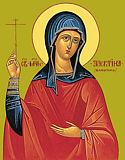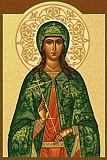

| Previous day | Next day |
| Old Style
July 16
|
Monday |
New Style
July 29
|
| 7th Week after Pentecost. Tone 5. | No fast.
|
![]() Hieromartyr Athenogenes, bishop of Heracleopolis, and his ten disciples (ca. 311).
Hieromartyr Athenogenes, bishop of Heracleopolis, and his ten disciples (ca. 311).
Martyrs Paul and two sisters, Chionia (Thea) and Alevtina (Valentina), at Caesarea in Palestine (308). Martyr Antiochus, physician, of Sebaste (4th c.). Commemoration of the Fourth Ecumenical Council (451). Virgin-martyr Julia of Carthage, at Corsica (440). St. Theodotus, monk of Glinsk Hermitage (1859). St. Magdalena, schema-abbess of New Tikhvin Convent in Siberia (1934). Synaxis of Russian Saints glorified at the Moscow Councils of 1547 and 1549.
New Confessor Matrona Belyakova, fool-for-Christ, of Anemnyasevo (1936). New Hieromartyrs James (Maskaev), archbishop of Barnaul, and priests Peter and John, and with them Monk-martyr Theodore (Nikitin) and Martyr John (1937). New Hieromartyr Ardalion (Ponamarev), archimandrite, of Kasli (Chelyabinsk) (1938).
Icon of the Mother of God of Chirsk-Pskov (1420).
Martyr Helier of Jersey (6th c.). St. John of Vishnya and Mt. Athos, activist against Uniatism (c. 1630). New Martyr John of Turnovo (1822). 15,000 Martyrs of Pisidia.
Thoughts for Each Day of the Year
According to the Daily Church Readings from the Word of God
By St. Theophan the Recluse

Monday. [I Cor. 5:9-6:11; Matt. 13:54-58]
The Nazarenes did not believe the word of the Lord, because when He lived in amongst them, He had no attractive lustre or outward dignity that would command involuntary respect from all. “We know who He is,” they said; “there can’t be anything extraordinary about Him.” Their reaction, however, did not induce the Lord to assume an imposing appearance. He remained extremely simple in appearance; later the Apostles bore themselves the same way, as did all of those who truly followed and emulated them. Why is this so? Because it is there is no man-made lustre that could fully correspond to the light of life in Jesus Christ. Moreover, we recognize that it is better to relegate external appearance the lowest value, so that it does not block what is within. Let him who has eyes to see look directly at the latter, without arresting his attention upon the former. The holy Apostle Paul expressed it like this: We have this treasure in earthen vessels (II Cor. 4:7). If we could see what was the outward appearance of those persons whom we now revere and call upon in prayer, we would not believe our eyes—they were so simple. But to this day, those who have come to know the life in Jesus Christ abandon care for their outward appearance and turn fully within. That is why the former falls away on its own, but the latter is raised up and grows. It often happens that nobody even notices this inner brightness, not even the one who possesses it. The human eye is evil; it is not shown what is truly good, if this good can harm it.
Articles
 Martyr Antiochus the Physician of SebasteThe Holy Martyr Antiochus, a native of Cappadocian Sebastea, was the brother of the holy Martyr Platon (November 18), and he was a physician. |







